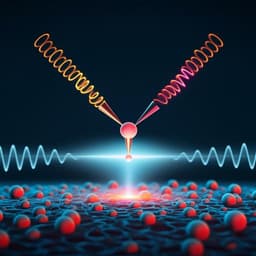
Physics
Quantum read-out for cold atomic quantum simulators
M. Gluza, T. Schweigler, et al.
This groundbreaking research conducted by M. Gluza, T. Schweigler, B. Rauer, C. Krumnow, J. Schmiedmayer, and J. Eisert unveils a novel method for probing quantum simulators. Harnessing coherent non-interacting dynamics, the study reveals new insights into second moments of density fluctuations in one-dimensional superfluids, paving the way for exciting explorations in equilibration and thermalization dynamics.
~3 min • Beginner • English
Introduction
The study addresses a key bottleneck in quantum simulators: limited access to quantum observables during read-out, which restricts insight into many-body dynamics and equilibration. In one-dimensional superfluids, experiments can measure relative phase fluctuations but not the canonically conjugate relative density fluctuations, impeding a complete quadrature read-out. The research question is whether coherent, known non-interacting dynamics following a quench can be used to mix quadratures so that measuring only the phase at multiple times suffices to reconstruct the unobserved density fluctuations and the full second-moment (covariance) structure of the initial state. The work proposes and demonstrates a practical tomographic read-out scheme exploiting effective free-field (phononic) dynamics to enable recovery of otherwise inaccessible correlations, thereby enabling genuine quantum read-out and improved characterization of state preparation, equilibration, and recurrences in 1D superfluids.
Literature Review
Quantum simulators with ultracold atoms provide controlled platforms for exploring out-of-equilibrium many-body physics, including phenomena like generalized Gibbs ensembles and light-cone spreading of correlations. However, read-out limitations are widespread across platforms, motivating techniques such as quantum gas microscopy that have previously transformed lattice studies. Theory work has proposed leveraging deterministic or random unitary dynamics to expand measurement capabilities and enable tomography, akin to homodyne-like quadrature rotation in quantum optics where access to one quadrature allows inference of its conjugate. The present setting extends these ideas to a genuine multi-mode continuum system (1D superfluids) where low-energy dynamics are well captured by effective free phonon theories (Luttinger-like), enabling practical state reconstruction from time-resolved phase measurements. Prior experiments on tunnel-coupled 1D Bose gases observed prethermalization, generalized Gibbs ensembles, higher-order correlations, and recurrences; these motivate a method that can infer full quadrature information to quantify initial conditions, coherence, and interaction effects beyond quadratic models.
Methodology
System: two adjacent 1D Bose gases on an atom chip form a relative (antisymmetric) sector described by an effective phonon Hamiltonian with phase and density fields φ(z) and δρ(z). The Hamiltonian consists primarily of a Luttinger-like quadratic form determined by the GP profile n_GP(z) and interaction g(z), yielding discrete eigenmodes due to finite cloud size R_1D. Real-space fields are expanded in eigenmodes with operators {φ_k, δρ_k} that satisfy canonical commutation relations. In eigenmode space the Hamiltonian is diagonal and each mode undergoes harmonic rotation; under Heisenberg evolution, φ_k(t) and its conjugate p_k ≡ δρ_k mix within the same mode without inter-mode coupling.
Measurement: the experiment measures referenced two-point correlations of the relative phase via matter-wave interferometry, Φ(z, z', t) = ⟨(φ(z,t)−φ(z0,t))(φ(z',t)−φ(z0,t))⟩, removing the global phase mode. Imaging has finite resolution; theoretical predictions are convolved with a Gaussian (σ ≈ 3.5 μm) and sampled at camera pixel spacing δ ≈ 2 μm.
State preparation and quench: initially the two gases are tunnel-coupled, leading to an initial Hamiltonian H_ini = H + J ∫ dz n_GP(z) φ(z)^2 that energetically suppresses phase fluctuations. The system is quenched by ramping J to zero over 2 ms; t = 0 ms is at the ramp midpoint. Subsequently the system evolves under H and Φ(z, z', t) is measured at equidistant times Δt = 2.5 ms.
Reconstruction framework: assume the initial state is approximately Gaussian so it is fully characterized by its covariance matrix V over N lowest modes, V = [[V_QQ, V_QP],[V_PQ, V_PP]], with Q ≡ (φ_1,…,φ_N), P ≡ (p_1,…,p_N). Time evolution gives V(t) = G_t V G_t^†, with G_t block-diagonal in modes using cos(ω_k t) and sin(ω_k t). The observable Φ(z,z',t_i) is linear in mode-space second moments with coefficients set by eigenmode functions and referencing.
Optimization: collect all measured Φ values into a data vector b across positions (z,z') and times t_i. Define a linear map A(V) that outputs model predictions for these entries given trial V and the known dynamics G_t. Solve a convex quadratic program with semidefinite constraint to enforce physicality (Heisenberg uncertainty): minimize ||W(A(V) − b)||_2 subject to Q(V) ≥ 0 (a positivity constraint on a linear function of V reflecting uncertainty bounds). W is diagonal with entries σ(z,z',t_i)^{-2} weighting by measurement uncertainty. The optimization is implemented with standard semidefinite programming (e.g., CVX). A cutoff N ≈ 10 modes is used, justified by finite imaging resolution suppressing higher modes.
Experimental specifics used in reconstruction: N_avg ≈ 3400 atoms per gas, box-like trap giving R_1D ≈ 25 μm; n_GP(z) from GP equation sets H and eigenmodes; imaging convolution σ ≈ 3.5 μm; input times for initial reconstruction t = 1, 3.5, 6, 8.5, 11, 13.5 ms. Additional reconstructions use different time windows (including seemingly dephased intervals) to predict dynamics and assess damping.
Validation and analysis: compare reconstructed Φ_Rec to data Φ_Data to assess fit; examine V’s block diagonality in eigenmode basis to test mode identification; fit diagonal variances to a thermal model of H_ini to estimate temperature T and coupling J; propagate V to predict recurrence dynamics; perform sliding-window reconstructions to extract time series of mode-resolved central moments and phonon occupations n_k(t) = (⟨φ_k^2⟩ + ⟨p_k^2⟩ − 1)/2 (up to conventions), assessing constancy under H and damping of quadrature oscillations.
Key Findings
- Successful quantum read-out: From time-resolved phase-only measurements, the method reconstructs the full covariance matrix V of the lowest eigenmodes, including density-density and phase-density correlations that are not directly measurable.
- Consistency with effective phonon theory: The reconstructed V is close to diagonal in the numerically obtained eigenmode basis, indicating that the eigenmodes are well captured and that inter-mode mixing is negligible within the effective model.
- Quantitative parameters of the initial state: Fitting the diagonal mode variances to a thermal state of the pre-quench Hamiltonian H_ini yields T ≈ 52 nK and an effective tunnel coupling J ≈ 2 × 1.1 Hz for the first few resolvable modes, after correcting for imaging resolution.
- Suppressed phase fluctuations: The initial state exhibits phase fluctuations an order of magnitude smaller than density fluctuations, consistent with energetic suppression by tunnel coupling in H_ini.
- Predictive dynamics and recurrences: Using reconstructed V from limited input windows (including seemingly dephased times), forward propagation predicts partial recurrences of phase correlations driven by an approximately linear spectrum; qualitative agreement is observed, with quantitative deviations at long times attributable to higher-order interaction effects beyond the quadratic model.
- Phonon occupations are nearly conserved: Mode occupations n_k(t) for k = 1,…,5 remain approximately constant over tens of milliseconds, consistent with constants of motion under H; small trends depend on system size (additional data suggest possible slow increases).
- Damped quadrature oscillations: While n_k(t) are near-constant, the oscillations between phase and density variances within each mode are clearly damped over time, indicating loss of initial quadrature squeezing rather than changes in occupation as the primary source of recurrence damping.
- Practical robustness: Reconstructions using short, dephased time windows work but are more sensitive to finite sample size, yielding larger uncertainties; nonetheless, short-time predictions remain accurate.
Discussion
The central objective—enabling genuine quantum read-out in a system where only one quadrature is directly measurable—is achieved by leveraging known non-interacting dynamics to mix quadratures and reconstruct the full covariance matrix. This addresses the read-out bottleneck in 1D superfluids and validates the effective phonon description: the near-diagonality of V in the eigenmode basis and the ability to predict recurrences indicate coherent multi-mode evolution with minimal inter-mode coupling. The parameter estimation (T and J) from reconstructed moments quantitatively characterizes the state preparation, revealing strong suppression of phase fluctuations consistent with the tunnel-coupled initial Hamiltonian. Dynamically, predictions of recurrences from dephased data highlight the method’s predictive power and the system’s coherence; discrepancies at long times point to interaction terms beyond the quadratic effective model, providing a diagnostic for when higher-order processes become relevant. The near-constancy of n_k(t) alongside damping of quadrature rotations implies that apparent equilibration and reduced recurrence contrast stem primarily from intra-mode dephasing of quadrature squeezing rather than energy redistribution among modes. Overall, the work demonstrates that time-resolved phase measurements combined with convex reconstruction can unlock access to unmeasured observables, enabling deeper studies of equilibration, thermalization, and interaction effects in cold-atom quantum simulators.
Conclusion
This work introduces and experimentally validates a tomographic quantum read-out method that reconstructs second moments of conjugate field quadratures in a multi-mode 1D superfluid from time-resolved phase-only measurements. By formulating a weighted least-squares problem with a semidefinite physicality constraint and incorporating known harmonic dynamics, the method yields full covariance matrices, enabling estimation of initial thermal parameters (temperature and tunnel coupling), prediction of recurrences, and monitoring of mode-resolved phonon occupations and quadrature dynamics. The approach confirms the efficacy of the effective phonon model while revealing damping of quadrature oscillations as a key mechanism limiting recurrence contrast. Future directions include: employing smaller and non-equidistant time steps to access higher modes and improve temporal resolution; extracting mode-resolved damping rates to benchmark theories of weak interactions beyond the quadratic model; optimizing quench protocols to better capture the true pre-quench state; and extending the general framework to other platforms (e.g., higher dimensions, lattice systems) for broader quantum state reconstruction and quantum information applications.
Limitations
- Imaging resolution limits accessible modes to the lowest few (N ≈ 10), suppressing higher-energy contributions and preventing meaningful comparison for higher modes.
- Reconstructions assume approximate Gaussianity; only second moments are recovered and no direct information about higher-order correlations is obtained for non-Gaussian states.
- Physicality constraint and model rely on accurate knowledge of eigenmodes and GP-derived density profiles; mismatches (trap imperfections, inhomogeneities) can induce off-diagonal and cross correlations, affecting accuracy.
- Decoupling ramp alters correlations, so the reconstructed state corresponds to an effective post-ramp initial condition rather than the state before the ramp; faster quenches would mitigate this.
- Predictions degrade at long times due to neglected higher-order interaction terms beyond the quadratic Hamiltonian (e.g., processes leading to damping), which the model cannot capture.
- Finite statistical sample sizes introduce uncertainties; reconstructions from short, dephased intervals are more sensitive to noise and yield larger error bars.
- Choice of mode cutoff and weighting influences results; practical performance depends on calibration of measurement uncertainties and convolution modeling.
Related Publications
Explore these studies to deepen your understanding of the subject.







